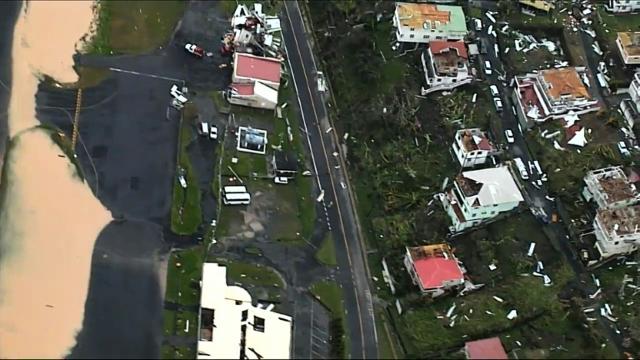Why are there medical students on this unknown island? What's going on that they're flying students to an unknown island to study medicine? I never heard of this place. What's going on? We're in places we really have no business, I mean all over Haitii, the Dominican Republic, and probably other places. Knowing the united states government's track record as well as other u.s. business interests, they're not there for the good of those people who reside there. Rather they were there to exploit these people, how I don't know but by and by the truth will come out.


Hurricane Maria causes major damage in Dominica
Video provided by AFP
Newslook
Hurricane
Maria killed at least seven people on the Caribbean island of Dominica
and prompted the Ross University School of Medicine to begin evacuating
its 25-acre campus by boat to a neighboring island.
Maria
crossed many Caribbean islands at Category 5 strength, lashing homes,
businesses and marinas that had already suffered terribly in Hurricane
Irma's wake. Widespread phone and power outages complicated efforts to
truly understand the scope of Maria’s destruction, which includes street
flooding, ripped-off roofs and an unknown number of casualties.
The back edge of Maria was still battering the islands Wednesday as the storm moved west across Puerto Rico.
On
the island of Dominica, aerial footage posted by the Caribbean Disaster
Emergency Management Agency showed scattered debris and what appeared
to be widespread damage. Officials confirmed at least seven deaths and
said they expected the toll to rise as rescuers dug through the rubble.
“The
country is in a daze — no electricity, no running water — as a result
of uprooted pipes in most communities and definitely no landline or
cellphone services on island, and that will be for quite a while,”
Hartley Henry, principal adviser to Prime Minister Roosevelt Skerrit,
told the Guardian newspaper after speaking to Skerrit via satellite phone.
“In
summary, the island has been devastated. The housing stock
significantly damaged or destroyed. All available public buildings are
being used as shelters, with very limited roofing materials evident,” he
said.
Officials are calling for helicopters to
help carry supplies to outlying areas, Henry said, and authorities hoped
to clear off runways and ports to allow relief vessels and large
aircraft to ferry in emergency aid.
At the Ross
University School of Medicine, workers there were conserving battery
power for their satellite phones and preparing to evacuate the entire
campus to neighboring St. Lucia, which escaped damage. HAM operators on
Dominica were broadcasting and sharing information via Facebook.
“Our
crisis team continues to be in communication with the U.S. State
Department about the possibility of a larger-scale military evacuation,
but as of now, moving forward with our evacuation plan is our best
choice,” Ross officials said in a website post Wednesday.
“We
plan to begin the transport of people with taking care of the children
and elderly first. Each family will be permitted to have one parent
travel with their children. We will also certainly transport anyone with
any serious injuries in this first group, although we are grateful to
report at this time that we have few reports of injuries, and those are
said to be somewhat minor,” the post said.
In 2015, Ross University opened a new student center designed to withstand Category 5 hurricanes, university officials said
On
the U.S. Virgin Islands, videos posted to social media showed downed
power lines and trees on St. Croix and widespread street flooding and
submerged cars on St. Thomas.
Larry Williams said
his family and friends rode out the storm in his St. Croix home, which
came through with little damage. Emerging afterward, however, he saw
widespread damage from the wind: “A lot of roofs are gone, but the
biggest damage is power poles that were snapped.”
Williams,
a commodities trader and father of actress Michelle Williams, said
heavy rains from the storm caused localized flooding, but he’d heard no
reports of injuries in his area. He said the island’s already-shaky
power supply would likely be offline for months, although many people
have diesel generators with limited fuel supplies. He said the biggest
challenge will be rebuilding infrastructure.
“It’s nothing that money can’t replace, but it’s going to take some time,” he said via a spotty cell phone connection.
St.
John resident Rebecca Reinbold, 33, evacuated before Maria arrived.
After riding out Irma with her husband and son, the family decided it
would be best for her husband, Chris, to stay on the island while she
and Hunter, 4, sought safety on the mainland from the second storm.
Reinbold, who is staying with friends in California, said she slept
about 15 minutes Tuesday night.
“I spent the night
feeling like I was going to throw up,” Reinbold said. “As the morning
has gone on, watching people check in on Facebook and check in statewide
has been everything.”
Reinbold said her husband
called her first thing Wednesday from a borrowed satellite phone but was
able to make a spotty cellphone call a little later in the day. That
tells her a lot about the damage: Irma took down cell service for five
days.
“There’s definitely damage, and water is the
main issue,” she said. “It’s still windy and they haven’t been able to
venture out to check on my mom.”
Reinbold,
a PR consultant, said island residents now face a new challenge in
persuading tourists to return. The islands are heavily dependent on
vacationers and honeymooners on tropical getaways, and the loss of those
visitors and their money will be catastrophic for the hotel staff,
bartenders, charter captains and wedding coordinators, she said.
“We
want to return, we want to rebuild,” she said. “But what do you do when
there are no jobs to return to? Most people on St. John … your job is
intrinsically tied to tourism and without tourism, there is no job.”
No comments:
Post a Comment